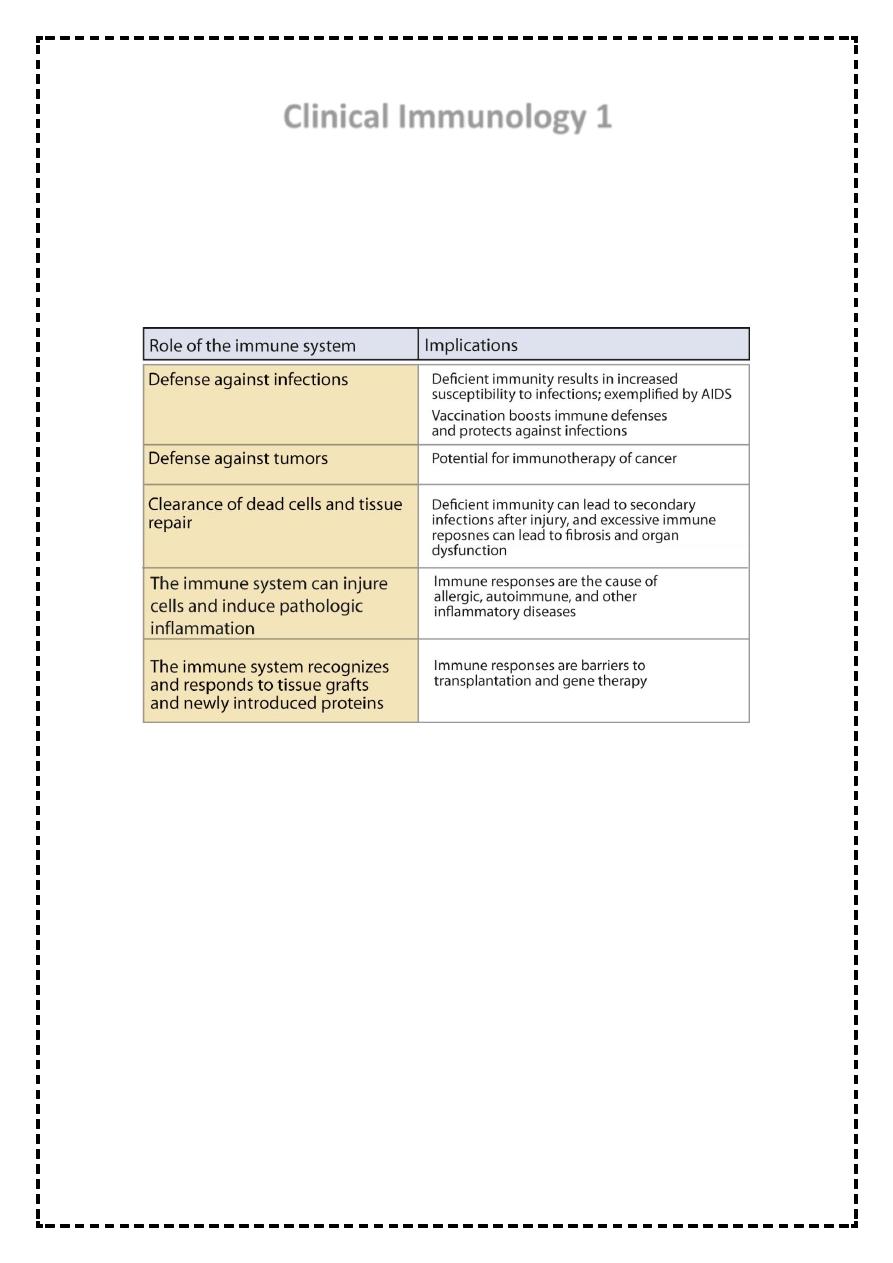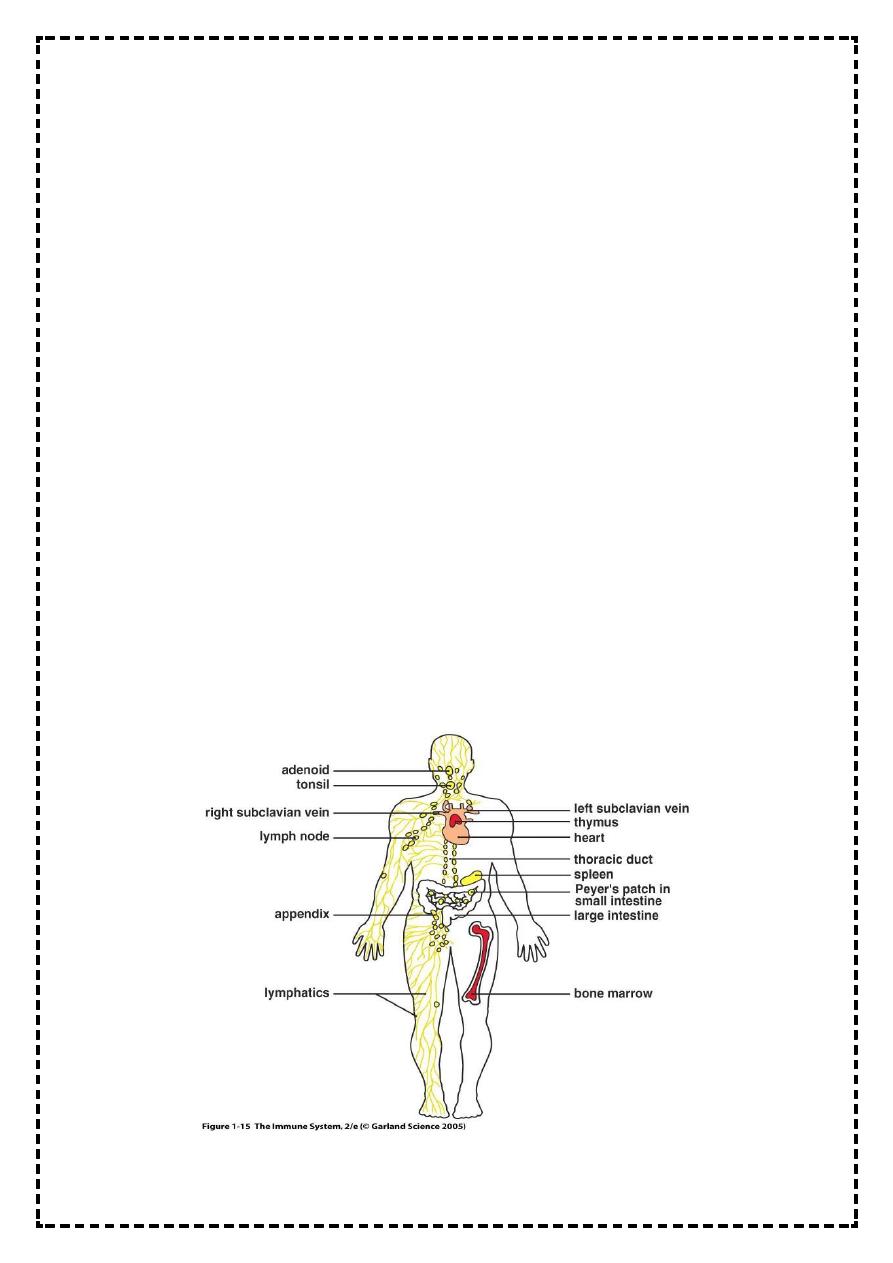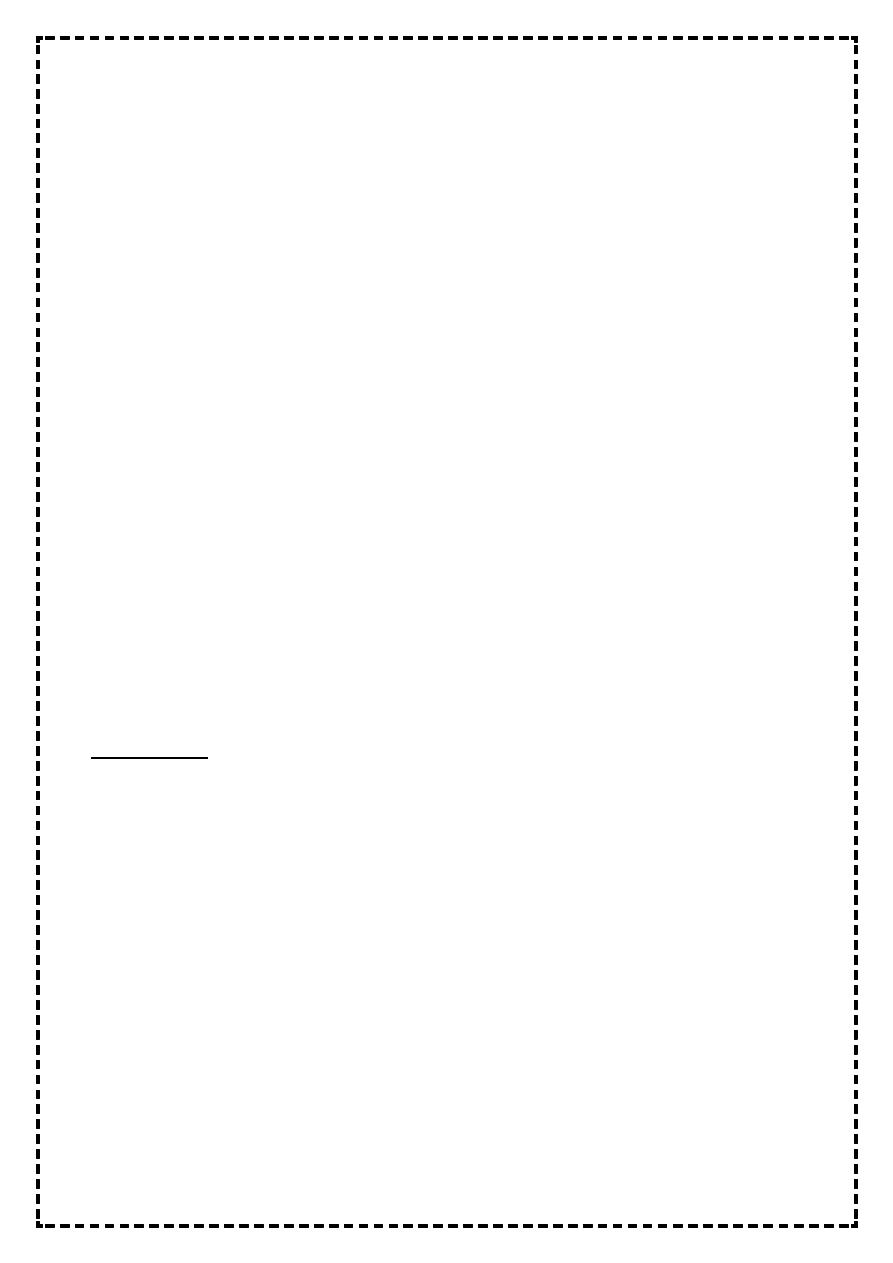
~1
~
Third Stage Internal Medicine Dr. Fadhil
Clinical Immunology 1
The Immune System
Immunity can be defined as protection from infection, whether it be due to bacteria,
viruses, fungi or multicellular parasites. Like other organs involved in human physiology, the
immune system is composed of cells& molecules organized into specialized tissues.
The functional importance of the immune system
How does the immune system respond to different infections?
– Different types of microbes are eliminated by different effector mechanisms,
which are designed to best combat each type of microbe
– Antigens are useful models for studying immune responses to microbes
PRINCIPAL FUNCTION OF THE IMMUNE SYSTEM
• To protect humans from pathogenic microorganisms
• Pathogenic microorganisms (Pathogens)
– Microorganisms capable of causing infection and/or disease
• Infection
– Ability of pathogen to enter host, multiply and stimulate an immune response
• Disease
– Clinical manifestations associated with infection

~2
~
DEFENSE MECHANISMS OF THE HUMAN HOST
• Innate Mechanisms (Innate immunity)
– First line of defense
– Non-specific
• Adaptive Mechanisms (Adaptive immunity)
– Second line of defense
– Highly specific with memory
• Cooperation between mechanisms
ORIGIN OF CELLS OF THE IMMUNE SYSTEM
• Derived from common progenitor cell in bone marrow
– Pluripotent hematopoietic stem cell
• Progenitor Stem Cells
– Erythroid lineage
• Erythrocytes and Megakaryocytes
– Myeloid lineage
• Monocyte/macrophage, dendritic cells, PMN’s, mast cells
– Lymphoid lineage
• Small and large lymphocytes

~3
~
The primary lymphoid organs are where the cells originate & develop into immature forms.
Cells& molecules of the immune system circulate in the blood, but immune responses do not
take place there.
Rather, an immune response is initiated at the site of infection(typically the mucosa or skin)
& then propagated & refined in the secondary lymphoid organs(eg. Lymph nodes).
After resolution of the infection, immunological memory specific for the pathogen resides in
cells(lymphocytes) in the spleen& lymph nodes as well as being widely secreted in a
molecular forms(antibodies)
The immune system is a network of cells, tissues, & organs that work together to defend the
body against attacks by "foreign" invaders& destroy them. These are primarily microbes_
tiny organisms such as bacteria, parasites, & fungi .
Viruses also can cause infections ,but they are too primitive to be classified as living
organisms. Animals of backbones called vertebrates have such advanced protective system &
human immune system is the most complex among other jawed vertebrates. The human
body provides an ideal environment for many microbes.
It is the immune system job to keep them out, or failing that, to seek out & destroy them. It
is amazingly complex. It is our free of charge body guard.
Although there are millions of potentially harmful pathogens, no pathogen can invade or
attack all organisms(humans & non humans) because a pathogen's ability to cause harm
requires a susceptible victim, & not all organisms are susceptible to same pathogens .
for instance, the virus that cause AIDS in humans does not infect animals such as dogs.
Similarly, humans are not susceptible to the viruses that cause mouse pox. Surprisingly,
immune system has evolved to recognize self from non self tissues, thereby it can protect
the host from pathogens and limits damage to self tissue.
Dysfunctions of immune system leads to a variety of diseases that may involve every part of
the body.
Over activity of various components of immune system leads to development of allergic
&autoimmune disease.
leukemia &lymphomas are the results of malignant transformation in the cells of the
immune system.
Two kinds of immunity:
All animals posses a primitive system of defense against the pathogens to which they are
susceptible. This defense is called the Innate, or natural immunity & includes two parts, one
part, called humoral innate immunity, involves a variety of substances found in the humors,
or body fluids.
These substances interfere with the growth of pathogens or clump them together so that
they can be eliminated from the body.

~4
~
The other part , called cellular innate immunity, is carried out by cells called phagocytes that
ingest & degrade, or "eat" pathogens& by so-called natural killer cells that destroy certain
cancerous cells.
Innate immunity is non specific---that is , it is not directed against specific invaders but
against any pathogens that enter the body.
Only vertebrates have an additional & more sophisticated system of defense mechanisms,
called adaptive immunity ,that can recognize &destroy specific substances. The defensive
reaction of the adaptive immune system is called the immune response.
Any substance capable of generating such a response is called an antigen, or immunogen.
Antigens are not the foreign microorganisms & tissues themselves; they are substances---
such as toxins or enzymes---in the microorganisms or tissues that the immune system
considers foreign. Immune responses are normally directed against antigen that provoked
them & are said to be antigen- specific.
. Specificity is one of the two properties that distinguish adaptive immunity from innate
immunity . The other is called immunologic memory. Immunologic memory is the ability of
the adaptive immune system to mount a stronger & more effective immune response against
an antigen after it is first encounter with that antigen, leaving the organism better able to
resist it in the future.
Adaptive immunity works with innate immunity to provide vertebrate with a heightened
resistance to microorganisms, parasites, & other intruders that could harm them. However,
adaptive immunity is also responsible for allergic reactions & for the rejection of transplanted
tissue, which it may mistake for a harmful foreign invader.
Innate immune system provides immediate protection against invading pathogens.
Adaptive(acquired)immune system takes more time to develop but confers long lasting
protection.
The innate immune system
Nonspecific response against infections, it usually takes minutes or hours & includes
1.anatomical barriers-the skin.
2.phagocytic cells such as neutrophils ,Monocytes & macrophages .
3.cytokines
4.complements pathway& acute phase proteins
5.mast cells& basophils- protect against allergic diseases
6.natural killer cells, granular lymphocytes-play a major rule against tumors &virally infected
cells.
Phagocytes=eating cells that kill m.o. they include
a -neutrophils; PMN leucocytes that are derived from BM& have short half life of 6 hours

~5
~
b-monocytes ¯ophages = monocytes are precursors of tissue macrophages. they are
produced in BM& have 5% of WBC. Example of tissue macrophages include kup''ffer cells of
liver, alveolar macrophage in lungs, mesangial cells in kidneys, µglial cells in brain.
Unlike neutrophils ,macrophages do not die after killing of pathogens.
Cytokines-
are small soluble proteins that act as chemical messengers.
More than 100 cytokines are described and act as immune modifiers. EX. interferon-alpha-
have antiviral activity.
. Other cytokines include interferon-gamma, tumor necrosis factor, interleukin 1,2,4,6&12.
Complement components ->20 proteins are described that promote inflammation &
eliminate invading pathogens.
There are 3 mechanisms for activation of complement cascade=
1.classical pathway(antibody-antigen immune complex).
2.alternative pathway(microbial surface).
3.lectin pathway(mannose binding pathway). These pathways activate C3& cause direct cell
lyses.
The adaptive immune system
This type of immunity is characterized by an antigen-specific response to a foreign antigen or
pathogen & generally takes several days or longer to materialize.
A key feature of immunity is memory for the antigen such that subsequent exposure leads to
more rapid & often a more vigorous response.
The dual limbs of the adaptive immune system consist of cellular & humeral immunity.
The principal effectors of cellular immunity is the thymus-derived ( T) lymphocyte,& of
humoral immunity is the bone marrow-derived or bursa-equivalent (B ) lymphocyte. Both B
& T lymphocytes are derived from common stem cell.
Regulator cells of the immune system are large granular lymphocytes (monocytes-
macrophages, & dendritic/ langerhans cells).
Bone marrow is the major site of maturation of B cells, monocytes-macrophages,&
granulocytes & contains pluripotent stem cells which, under the influence of various colony
stimulating factors, are capable of giving rise to all hematopoietic cell types.
T cell precursors also arise from hematopoietic stem cells but leave the yolk sac, fetal liver,
or bone marrow while they are immature and home to the thymus for completion of
maturation.
Mature lymphocytes, lymphocytes, monocytes, & dendritic/ langerhans cells enter the
circulation & home to peripheral lymphoid organs(lymph nodes& spleen) &the gut

~6
~
associated lymphoid tissues (tonsils, payer's patches & appendix ) as well as the skin &
mucous membranes & await activation by foreign antigen.
T lymphocytes differ from other immune effectors cell types in that the pool of effectors T
cells is established in the thymus early in the life & is maintained throughout life by antigen-
driven expansion of virgin peripheral T cells into ''memory'' T cells that reside primarily in
peripheral lymphoid organs.
Mature T lymphocytes constitute 70 to 80 percent of normal peripheral blood lymphocytes
(only 2 percent of the total body lymphocytes are contained in peripheral blood), 90 percent
of thoracic duct lymphocytes & 30-40 percent of lymph node cells&30 percent of spleen
lymphoid cells.
Cellular immunity is mediated by T-lymphocytes, which synthesize & release cytokines.
These interact closely with each other& with components of the innate immune system to
maximize the effectiveness of the immune response.
Lymphoid organs
a. primary lymphoid organs.
1-Bone marrow 2-thymus
b. Secondary lymphoid organs
1. spleen
2. lymph nodes
3. mucosa –associated lymphoid tissues
Humoral Immunity
B-lymphocytes
These cells arise from hemopoietic bone marrow stem cells, & there major function is to
produce an antibody.
Immunoglobulins
When a previously unstimulated B- lymphocytes are activated by an antigen, the first
antibody to be produced is IgM, which appears in the serum after 5-10 days. Depending on
additional stimuli provided by T- lymphocytes, other antibody classes like IgG, IgA& IgE are
produced 3-7 days later.
Cellular Immunity
T-lymphocytes mediate cellular immunity & are particularly important for defense against
viruses, fungi& intracellular bacteria.
